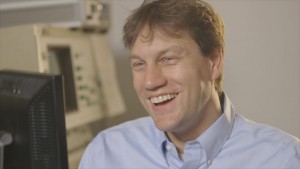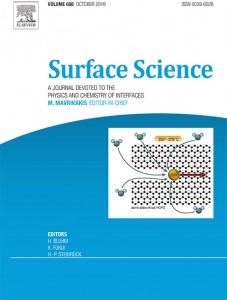Research Lands CSUN Prof on Cover of Respected Science Journal
California State University, Northridge physicist Henk Postma and his students were pondering the “what ifs” of their field when they came up with an idea that may make DNA sequencing research much easier. Their concept has landed on the cover of a respected scientific journal.

Hendrik Postma
Postma and three former students — Ian Carroll and Tanya Klowden, who earned their master’s degrees in physics in 2016 and 2019, respectively, and Isabel Alvarez, who earned her bachelor’s degree in electrical engineering with a minor in physics in 2018 — have come up with a simple way, using water and gold, to etch graphene, which may open up the field of DNA sequencing research to a wider array of scientists and change how graphene is used in the future.
“What we’ve done is open the door to what is possible,” Postma said. “My lab has come up with an easy way to break graphene. There’s a lot of work still to be done, such as refining the process. But the potential is exciting.”
Their findings were recently published in Surface Science, a journal dedicated to the physics and chemistry of interfaces. The journal’s editors were so taken with their findings that the editors featured an illustration of the work on its cover.
“That was entirely unexpected,” Postma said. “We didn’t learn we were on the cover until the journal came out.”

The cover of Surface Science, which features the work of CSUN physicist Henk Postma and his students.
Graphene is light, flexible and one of the strongest materials in the world. Due to its excellent conductivity, tunable electrical properties and atomic size, there is considerable interest in incorporating it into electronic devices. It has the potential to replace silicon in microprocessors.
For scientists, its high surface and charge mobility make it an ideal choice for future advanced DNA sequencing techniques. Researchers etch the surface of single-layer graphene — which is about as thick as an atom, or about 0.3 nanometers thick — to understand the small electrical variations involved in DNA sequencing.
The problem, Postma said, is that current graphene etching techniques require high temperatures, from 900 to 1,100 degrees Celsius. The high temperatures, in turn, require specialized laboratory equipment and can be quite costly.
“That can limit the opportunities for research, if only a few scientists have access to that level of equipment,” he said.
Postma and his students were “sitting around talking about ‘what ifs’ in our field when the idea came to us — what about using water and gold to cut graphene?” he said.
They were inspired by recent research that showed gold nanoparticles have some “surprising catalytically favorable properties,” Postma said. A catalyst is a substance that can be added to a reaction to increase the reaction rate.
By utilizing gold nanoparticles, Postma and his team were able to demonstrate a simple method to etch graphene at ambient air temperatures of 350 to 375 degrees Celsius.
The team used naturally occurring water vapor in the ambient air and the gold nanoparticles to etch “trenches” into an atom-thick, single-layer graphene top of graphite, Postma said.
“One of the trenches was really straight, which is the really exciting part of the technique because it opens the door to a whole slew of possibilities of what can be done with this technique,” he said. “This could be done with a hot plate. You don’t need any fancy gasses or a specialized laboratory. You just need a little gold and air.”
To test their theory that the water vapor in the ambient air was essential for etching the graphene, Postma and his team used a desiccator to remove the water and tried their technique again.
“It completely stopped working,” he said.
Postma said other researchers will need to replicate what they have done and explore the technique’s possibilities.
“Like all good science, it raises more questions about potential and possibi lities,” he said. “And that is exciting.”

 experience
experience